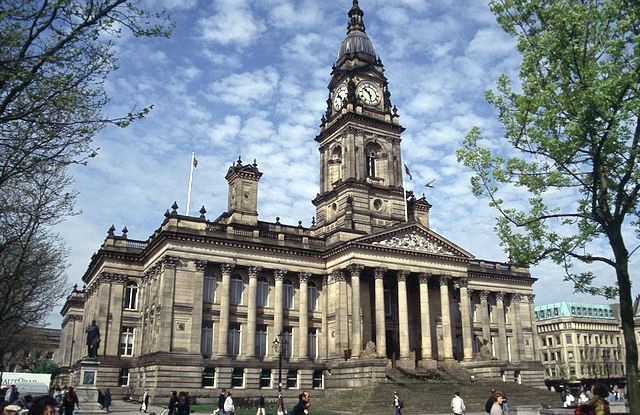Sovereign state United Kingdom | Constituent country England Founded 1 April 1974 | |
 | ||
The Metropolitan Borough of Bolton /ˈboʊltən/ is a metropolitan borough of Greater Manchester, England. It is named after its largest settlement, Bolton, but covers a far larger area which includes Blackrod, Farnworth, Horwich, Kearsley and Westhoughton, and a suburban and rural element from the West Pennine Moors. The borough has a population of 276,800, and is administered from Bolton Town Hall.
Contents
- Map of Bolton District UK
- History
- Parishes
- Demographics
- Population change
- Transport
- Education
- GCSE Examination Performance 2009
- Twin towns
- References
Map of Bolton District, UK
The boundaries the Bolton metropolitan district were set as part of the provisions of the Local Government Act 1972, and cover an amalgamation of eight former local government districts; seven Urban Districts from the administrative county of Lancashire, and the County Borough of Bolton. The metropolitan districts of Bury, Salford and Wigan lie to the east, south and west respectively; and the non-metropolitan districts of Blackburn with Darwen and Chorley in Lancashire lie to the north and north-west.
History
The metropolitan borough was formed on 1 April 1974, by the merger of the County Borough of Bolton and the following districts from the administrative county of Lancashire:
Bolton Council unsuccessfully petitioned Elizabeth II for the Metropolitan Borough of Bolton to be granted city status in 1992 (the Queen’s 40th year as monarch), in 2000 (for the Millennium celebrations), in 2002 (Queen’s Golden Jubilee), and 2012 (Queen's Diamond Jubilee).
Parishes
Horwich, Westhoughton and Blackrod are now constituted as civil parishes. There are three town councils in the metropolitan borough, Westhoughton Town Council, Horwich Town Council and Blackrod Town Council. The rest of the metropolitan borough, Bolton, Farnworth, Kearsley, Little Lever, and South Turton, have remained unparished areas since 1974.
Demographics
According to the 2009 estimates, of the 265,100 people living in Bolton Metropolitan Borough, the following ethnicities have been recorded:
Population change
The table below details the population change since 1801, including the percentage change since the last available census data. Although the Metropolitan Borough of Bolton has only existed since 1974, figures have been generated by combining data from the towns, villages, and civil parishes that would later be constituent parts of the borough.
Transport
The Bolton metropolitan area is served by the following railway stations:
Education
In 2007, Bolton was ranked 69th out of the 149 Local Education Authorities — and sixth out of ten in Greater Manchester — for its National Curriculum assessment performance. Measured on the percentage of pupils attaining at least 5 A*–C grades at GCSE including maths and English, the Bolton LEA was 111th out of 149: 40.1% of pupils achieved this objective, against a national average of 46.7%. Unauthorised absence from Bolton's secondary schools in the 2006/2007 academic year was 1.4%, in line with the national average, and authorised absence was 6.0% against the national average of 6.4%. At GCSE level, Bolton School (Girls' Division) was the most successful of Bolton's 21 secondary schools, with 99% of pupils achieving at least 5 A*–C grades at including maths and English.
The University of Bolton is one of Greater Manchester's four universities. In 2008, The Times Good University Guide ranked it 111th of 113 institutions in Britain. There are 4,440 students (83% undergraduate, 17% postgraduate); 2.6% come from outside Britain. In 2007 there were 8.8 applications for every place, and student satisfaction was recorded as 74.4%. It is one of Britain's newest universities, having been given this status in 2005.
GCSE Examination Performance 2009
Twin towns
The Metropolitan Borough of Bolton has two twin towns, one in France and another in Germany.
